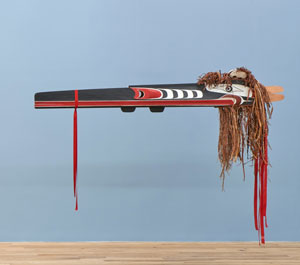5.10.24 — The Ultimate Sacrifice
Some artists sacrifice themselves for their art. Beau Dick sacrificed his art.
He saw his training in wood carving as a gift from his father, his grandfather, and an entire tradition, and he had no interest in wresting it from his Native American ancestry. This was not art for his sake or for art’s sake, but for his people, at Andrew Kreps through May 11. Did that mean reducing it to ashes? So be it. 
A documentary about Dick ends a solo show with an excuse to look back—at the deep past and at what one has just seen. It shows him shortly before his death in 2017 in context of others, a bearded activist and chief. When he speaks to the camera, though, he is just an artist entering his sixties and reflecting on his art. A quote on the wall sums up his dual identity. “Our whole culture has been shattered,” he says, leaving it “up to the artist to pick up the pieces” and, he adds, to “put them together, back where they belong.” At the very least, he can try.
The situation, then, is hopeless but not at all dire, as often happens when it comes to art. In fact, it looks downright cheerful—creative, colorful, and funny. While his masks cover a lot of ground, they give little sense of the artist’s development, because he may not have had one. They could be the cast of a single comedy, as “Walas Gwa’yam,” or big, great whale. As the film’s title has it, he was a “maker of monsters.” They just happen to look thoroughly at home on earth.
They include supernatural beings from the Kwakwaka’wakw people in remote western Canada, like the Man and Woman of the Forest. They look, though, not in the least like transcendent beings outside of time and space. They can be human or animal, and one can morph into the other. A reasonably human face sprouts long ears like a cartoon puppy, except that they are also the wings of an eagle rising above. The long snout of a fox or wolf could be a canoe. A flame seems to rise from another forehead, but it is only a feather, as if the most elaborate of headdresses needs no more to catch fire.
They adapt all sorts of materials and purposes, freestanding and along the walls. Some carvings have smooth surfaces, for sharper colors and blacks. Others have a coarser texture, like plaster, that deepens his colors. They could be wearing lipstick or war paint. If that sounds irreverent, it is not a dig at tribal culture, but a tribute to the culture’s punning, cunning irreverence. There, too, living creatures can change shape, and masks can change people.
His monsters might still be a threat, but to Canadian authorities that Dick held responsible for oppression. He saw his work in context of potlatch, a rite of gift giving, where sharing to him approaches socialism. Still, he was not creating idols to a lost cause. Diversity in art these days tends to mean a recovery of identity, as fixed and essential. Dick precludes that, much like Native American art in the 2024 Whitney Biennial, Melissa Cody at MoMA PS1, or Natalie Ball at the Whitney (and I tell you more about her next time). The motif of a canoe appears as well with Jaune Quick-to-See Smith, defining a history last year at the Whitney, but Dick refuses a proper unfolding.
On film, Dick plays the part of an activist and artist with roots in tradition. In art, he plays the role of a trickster. If the work ever seems light or repetitive, he took his responsibility seriously. He once brought his masks back to his home turf for use in a ceremony—and then he burned them. For an artist, it was the ultimate sacrifice, but not an ending. While he lived, he could always make more.
Read more, now in a feature-length article on this site.